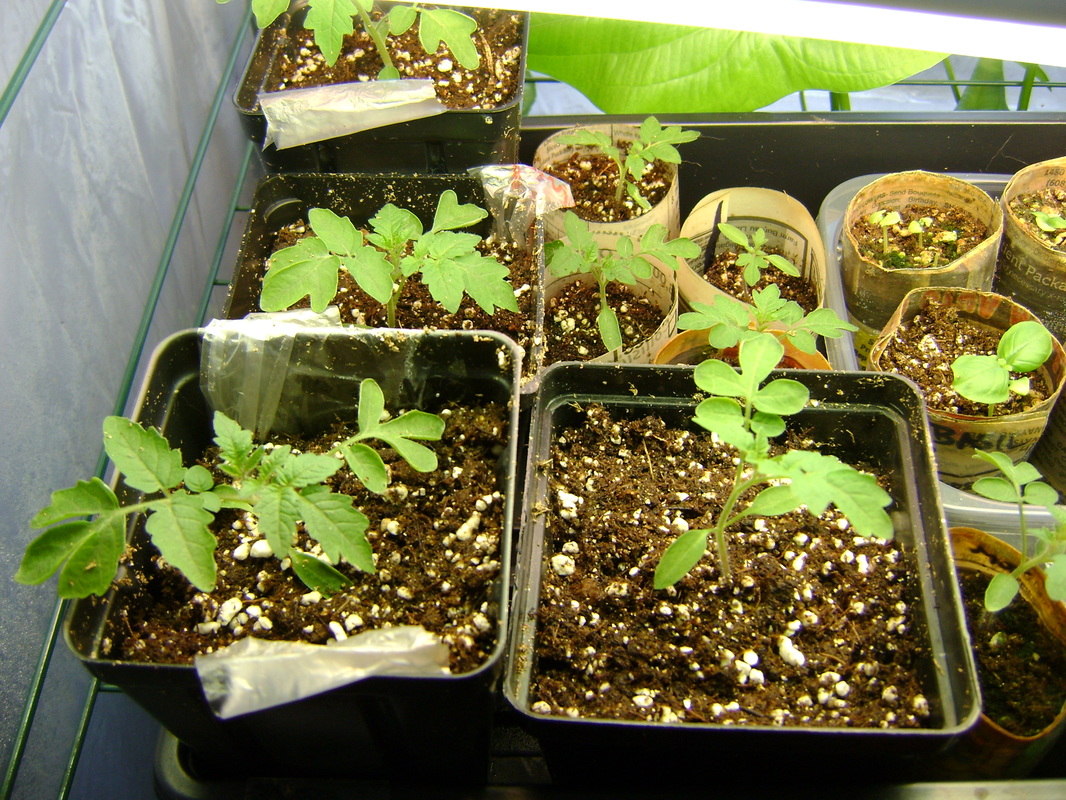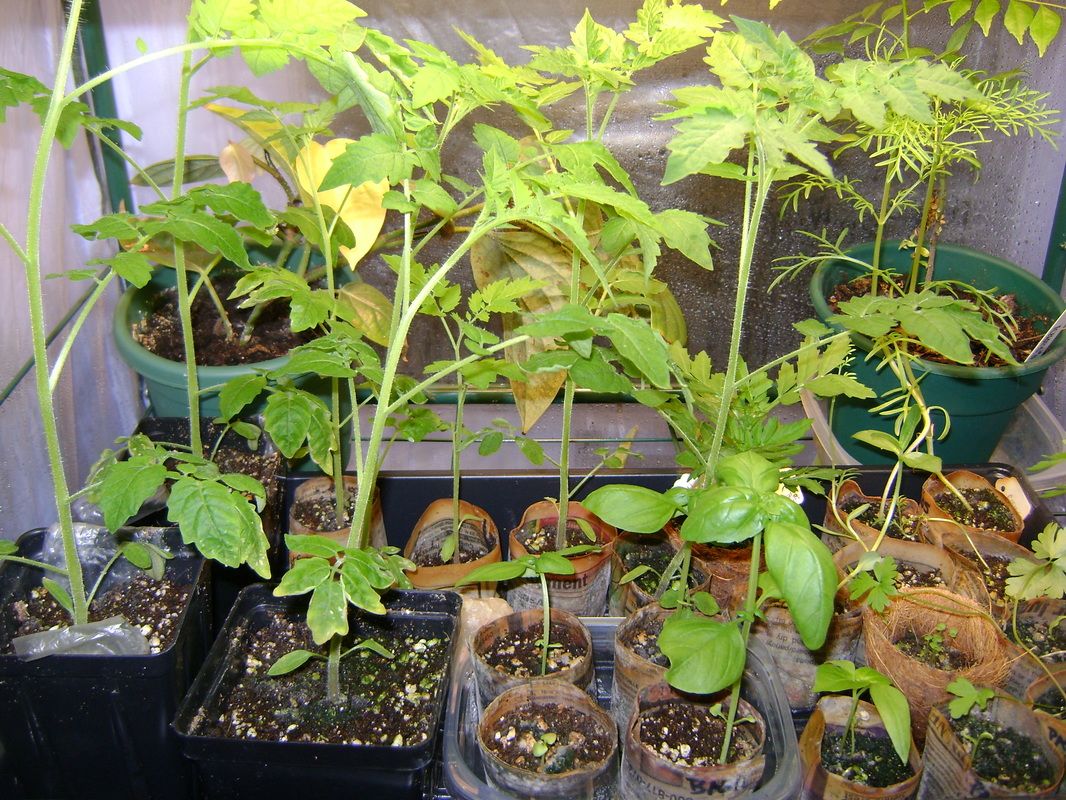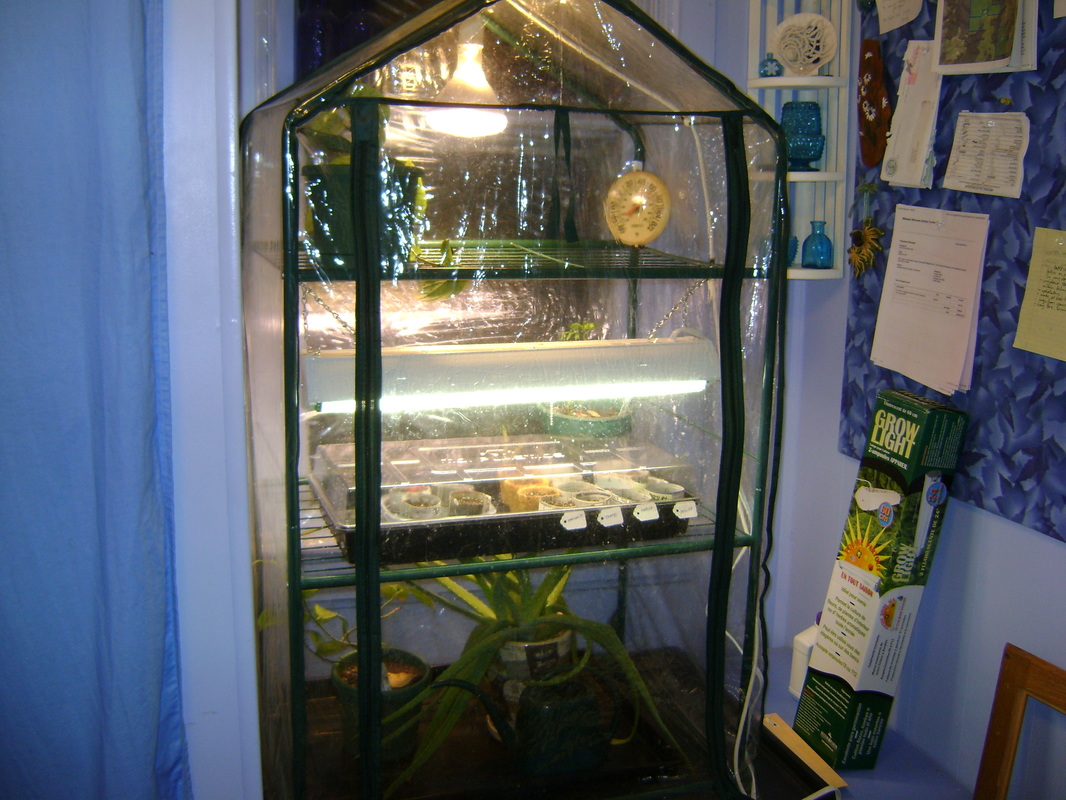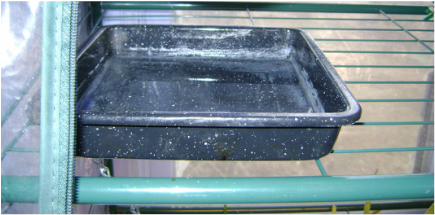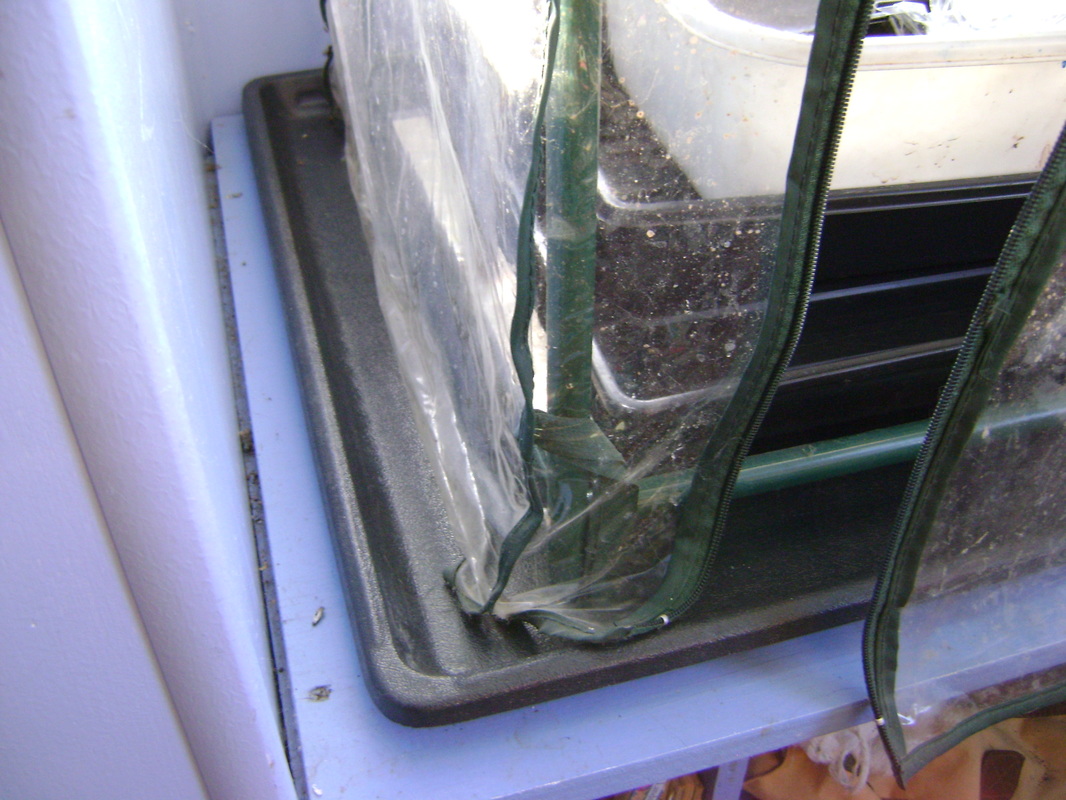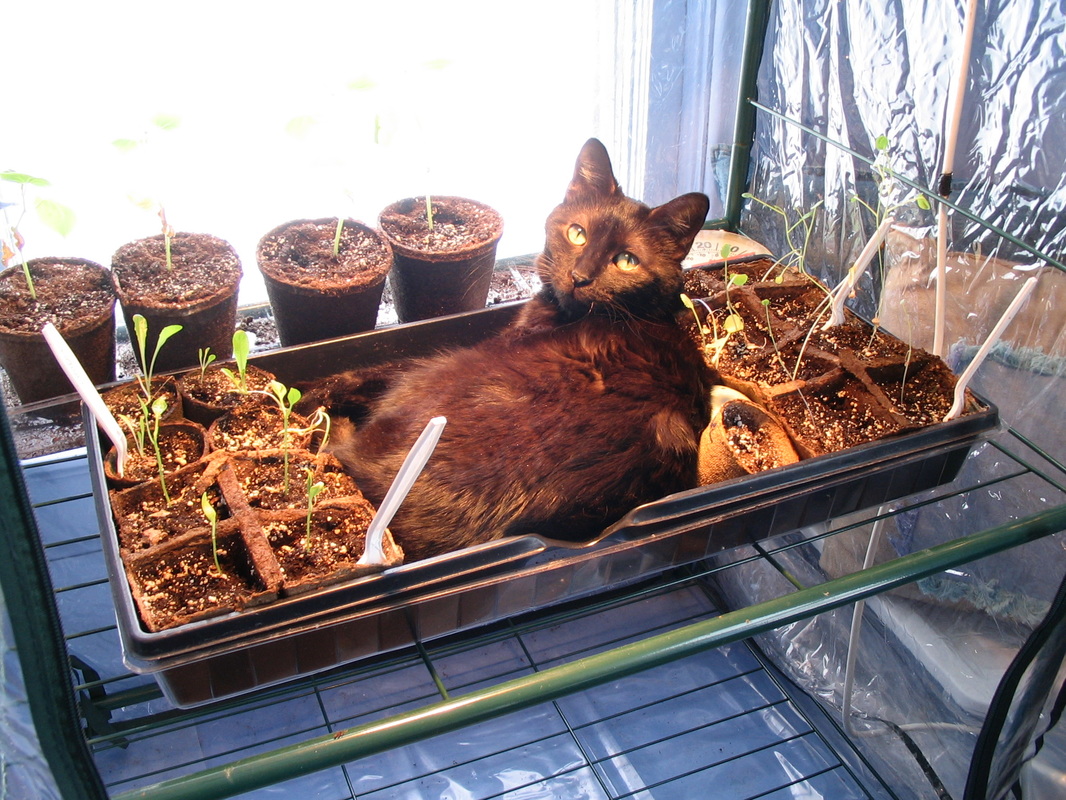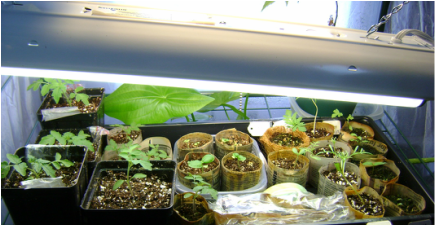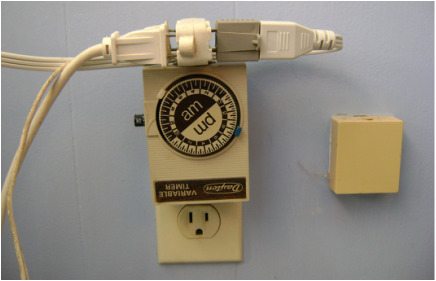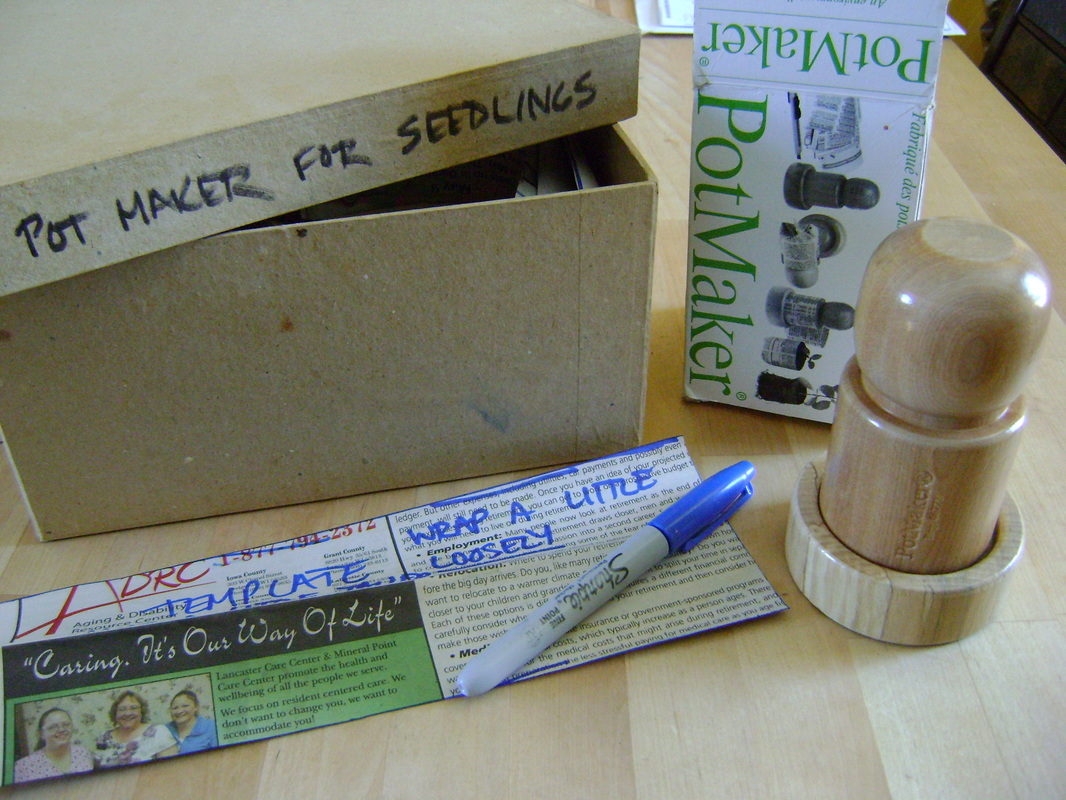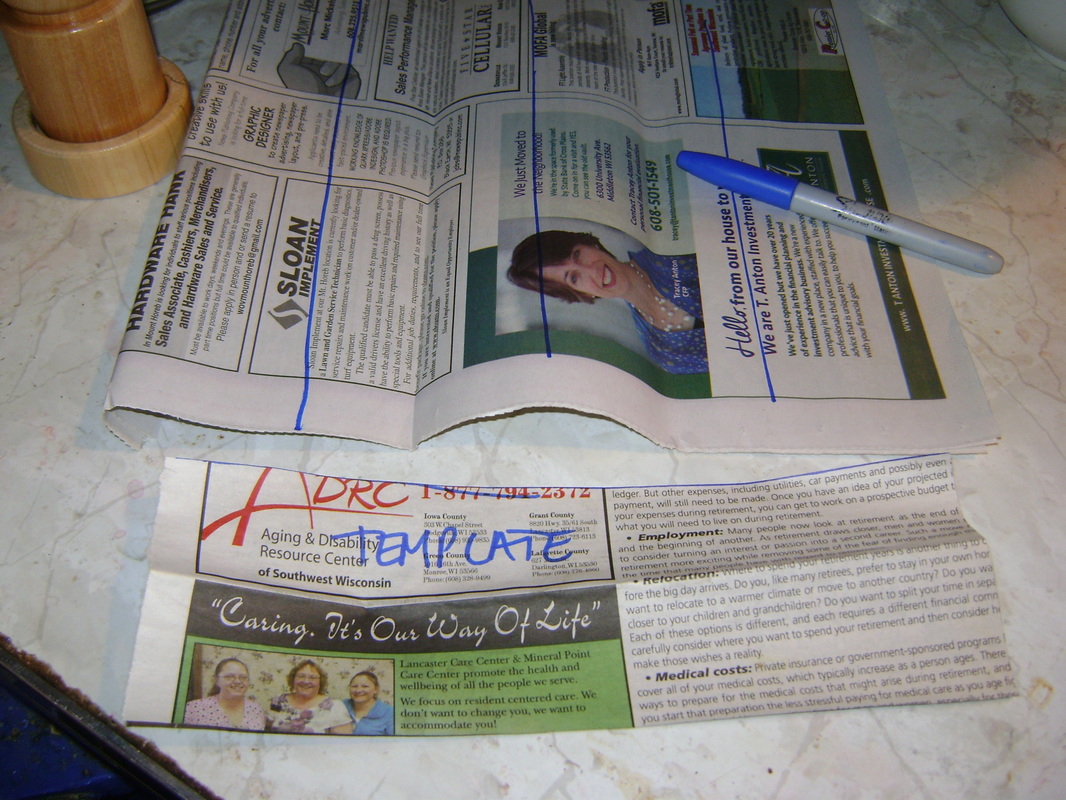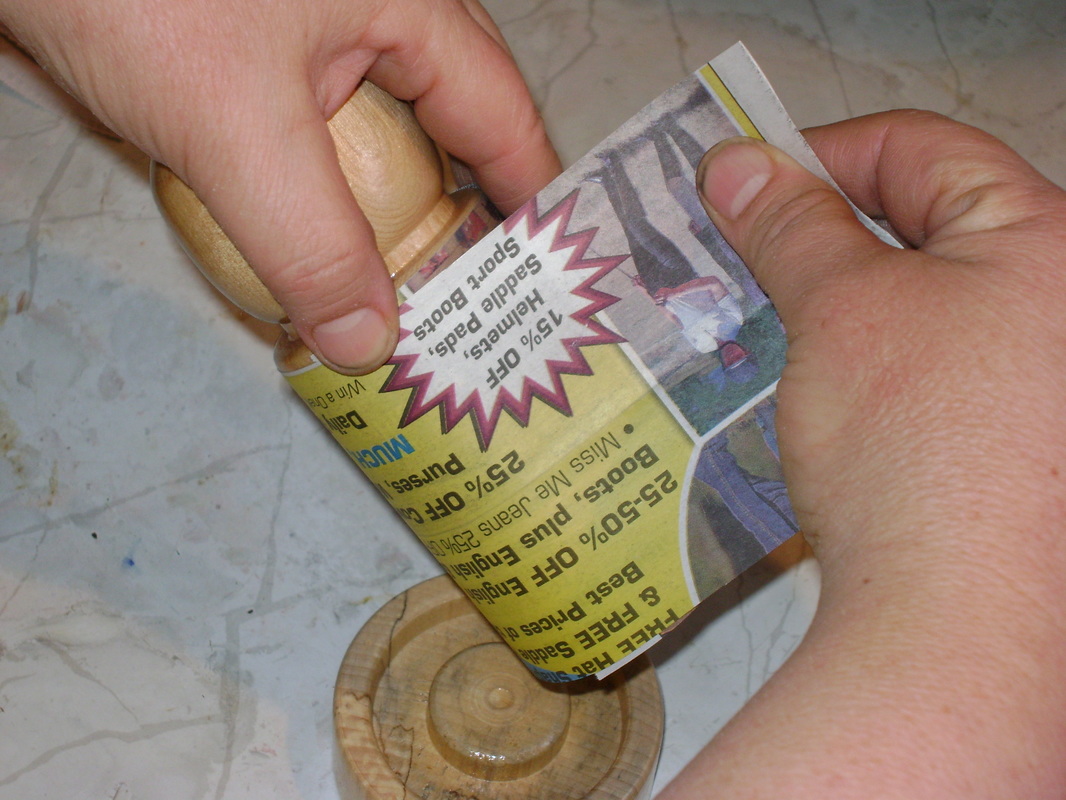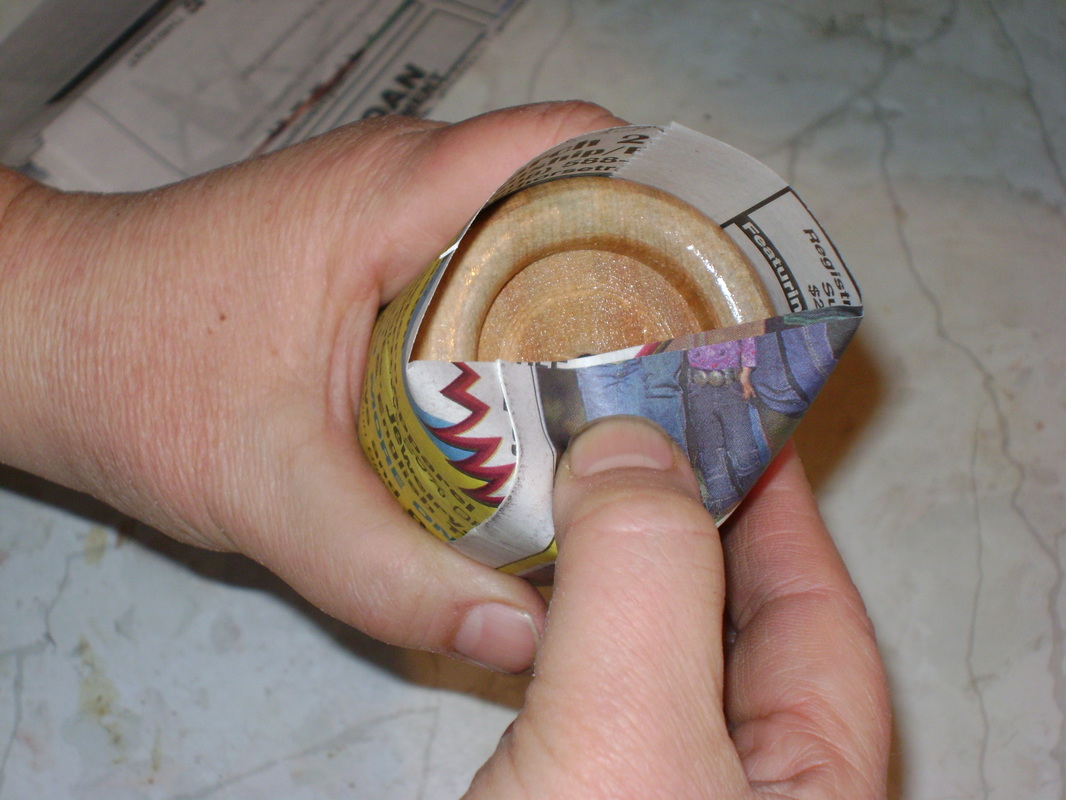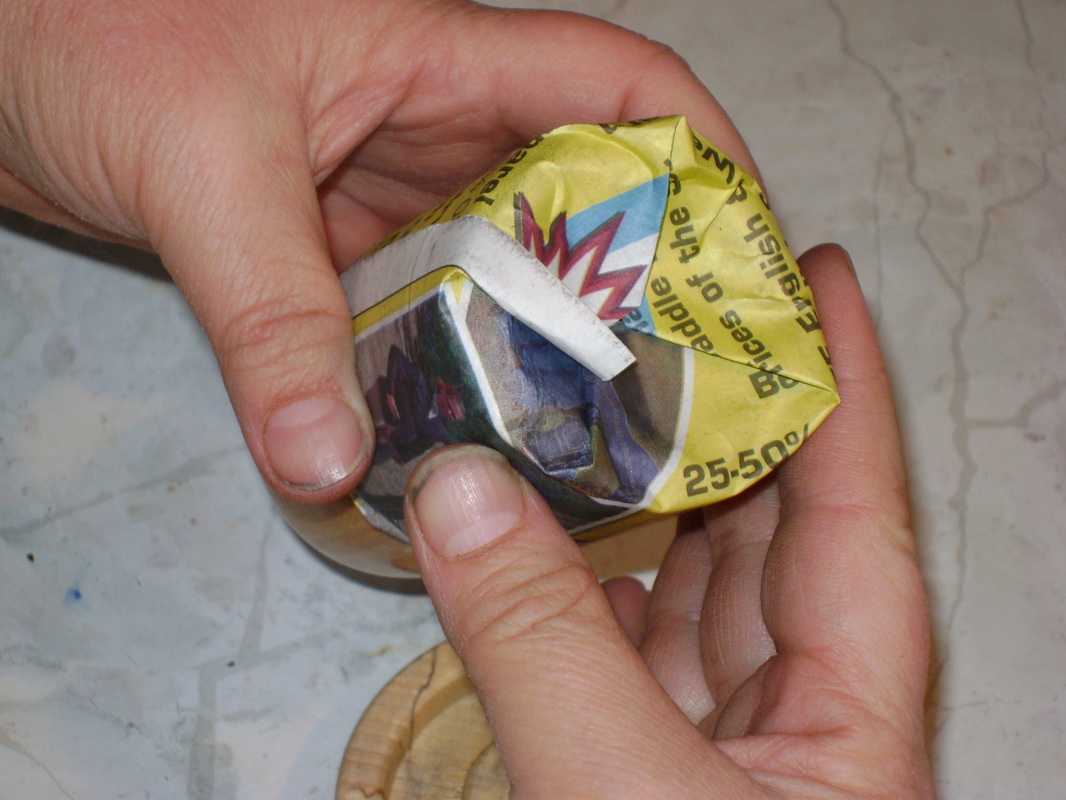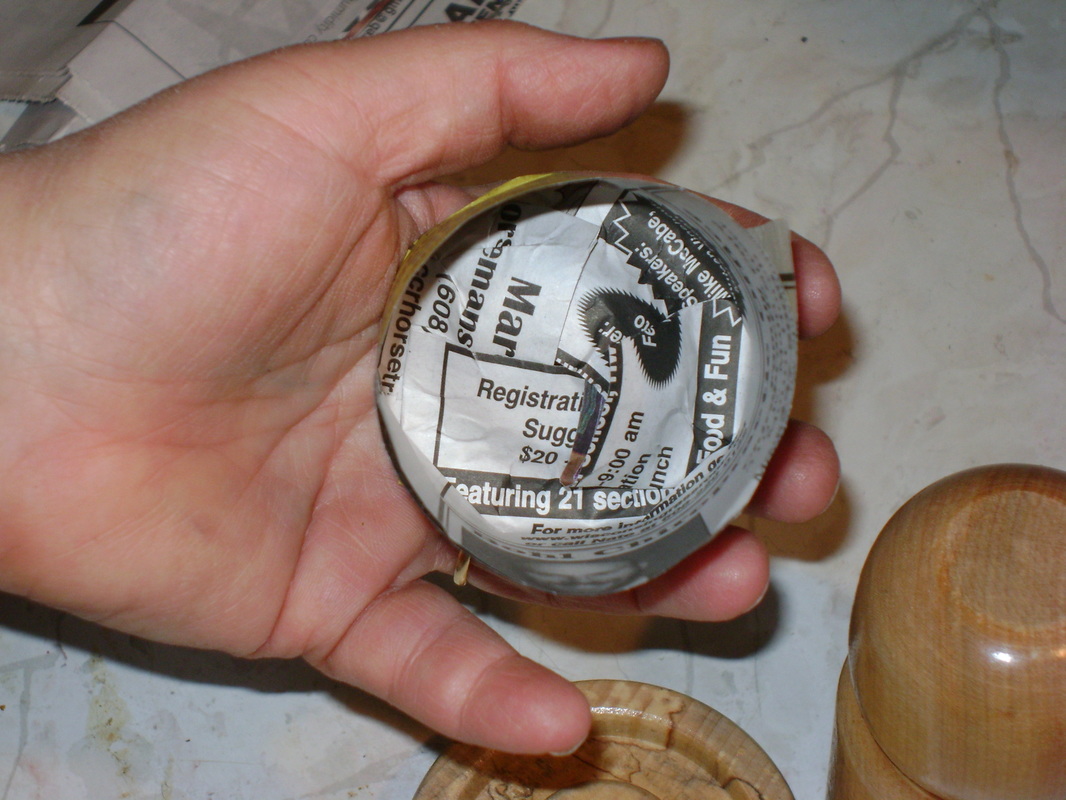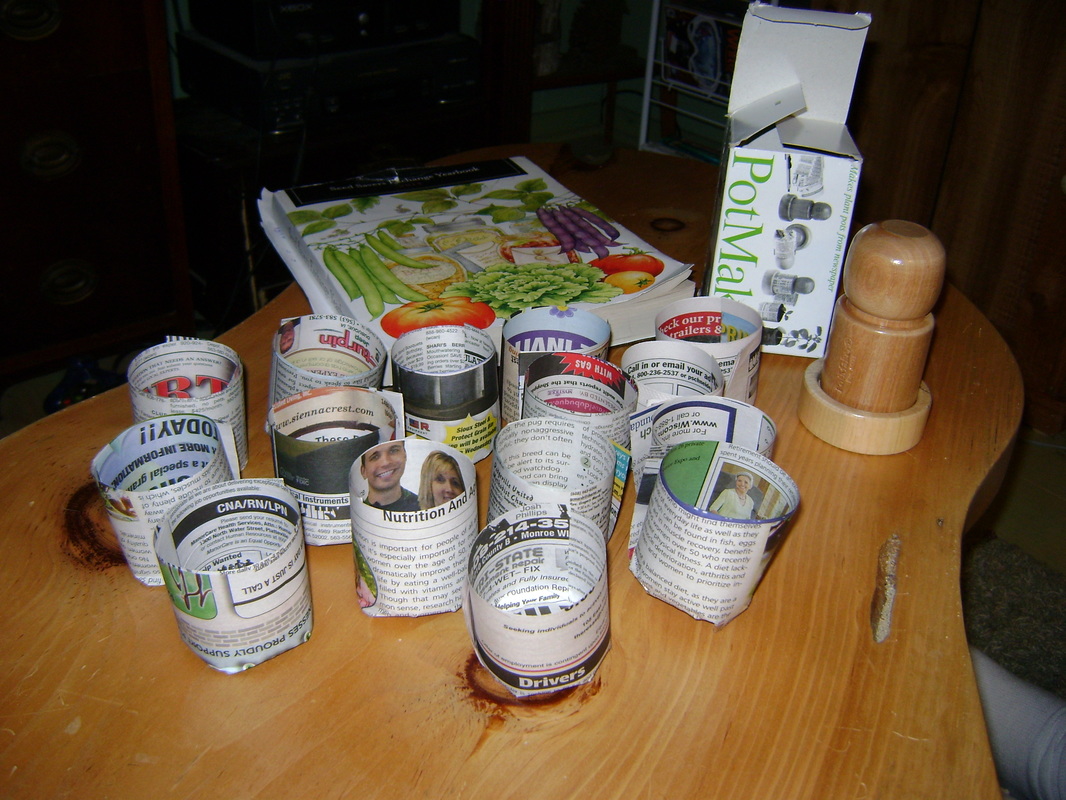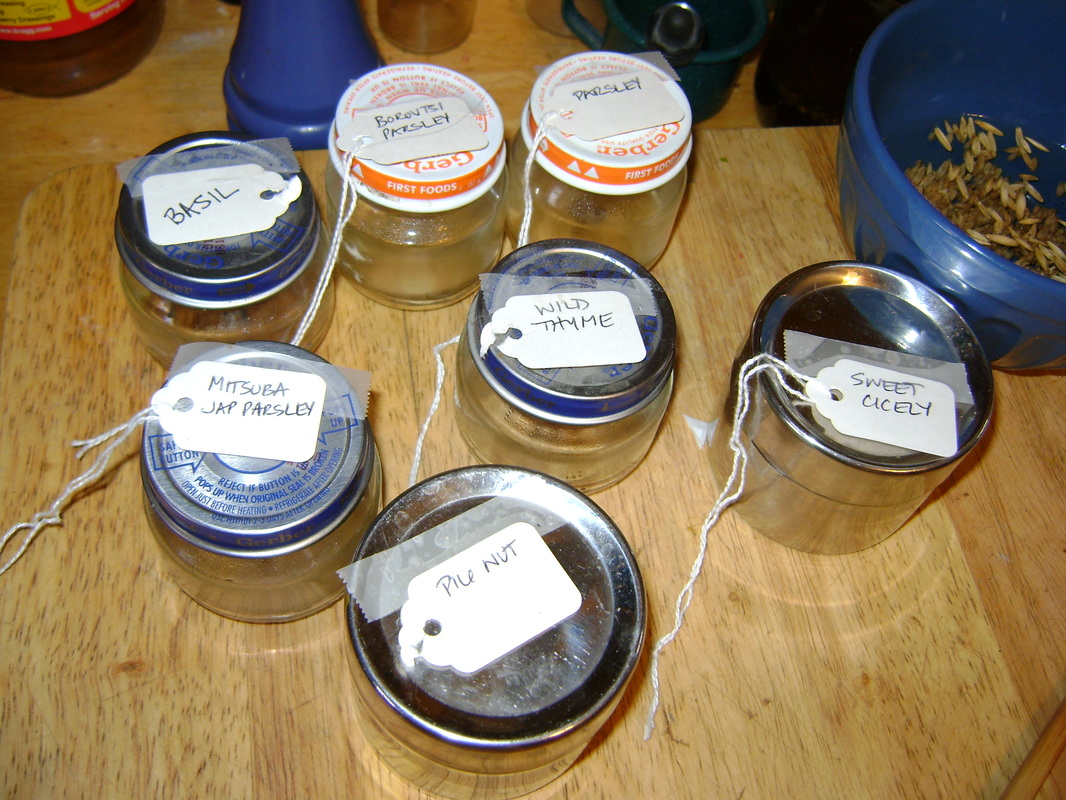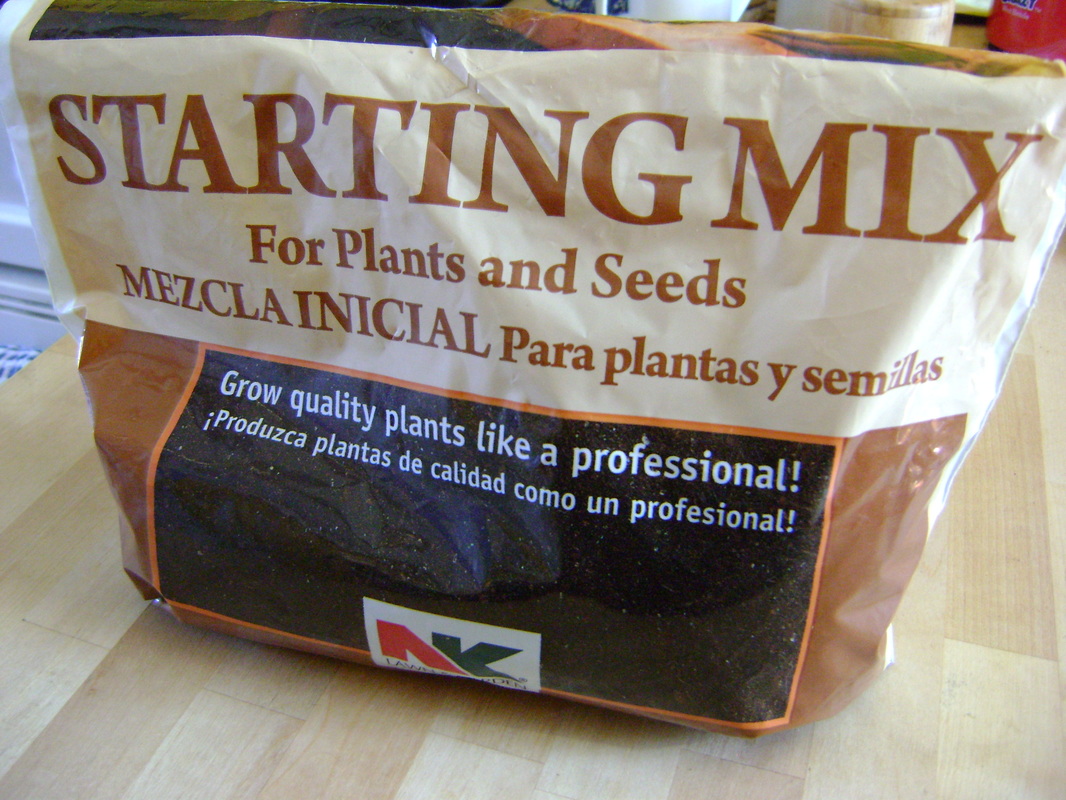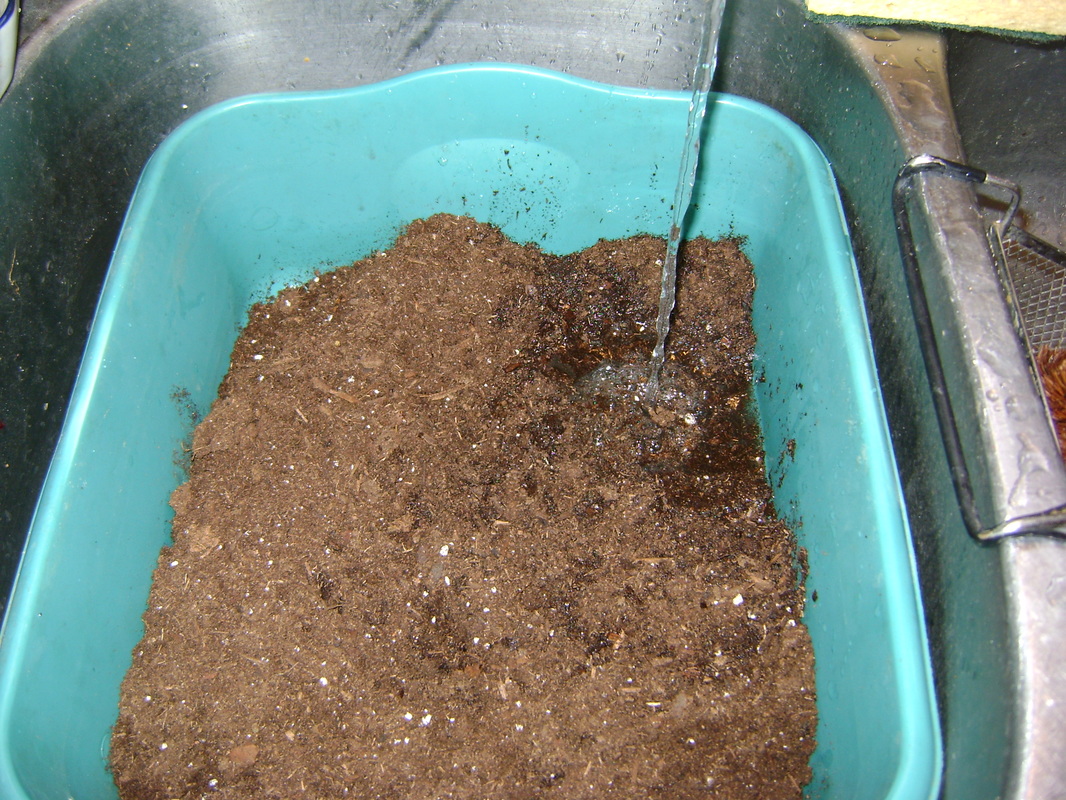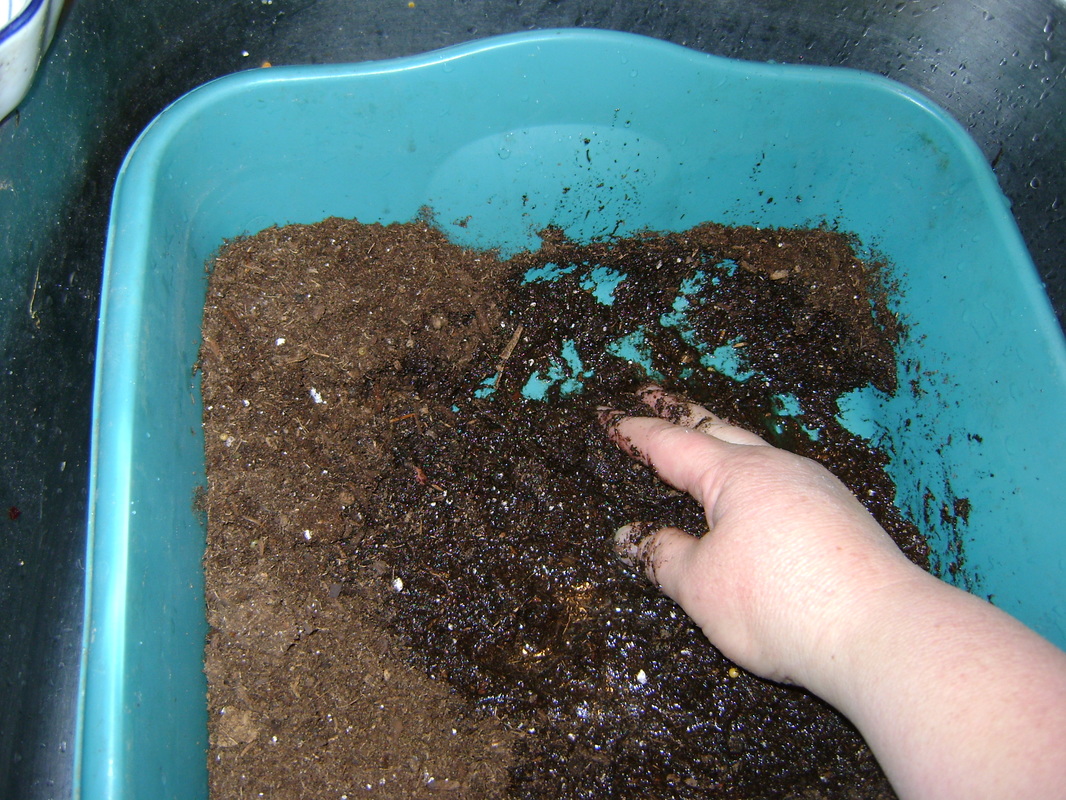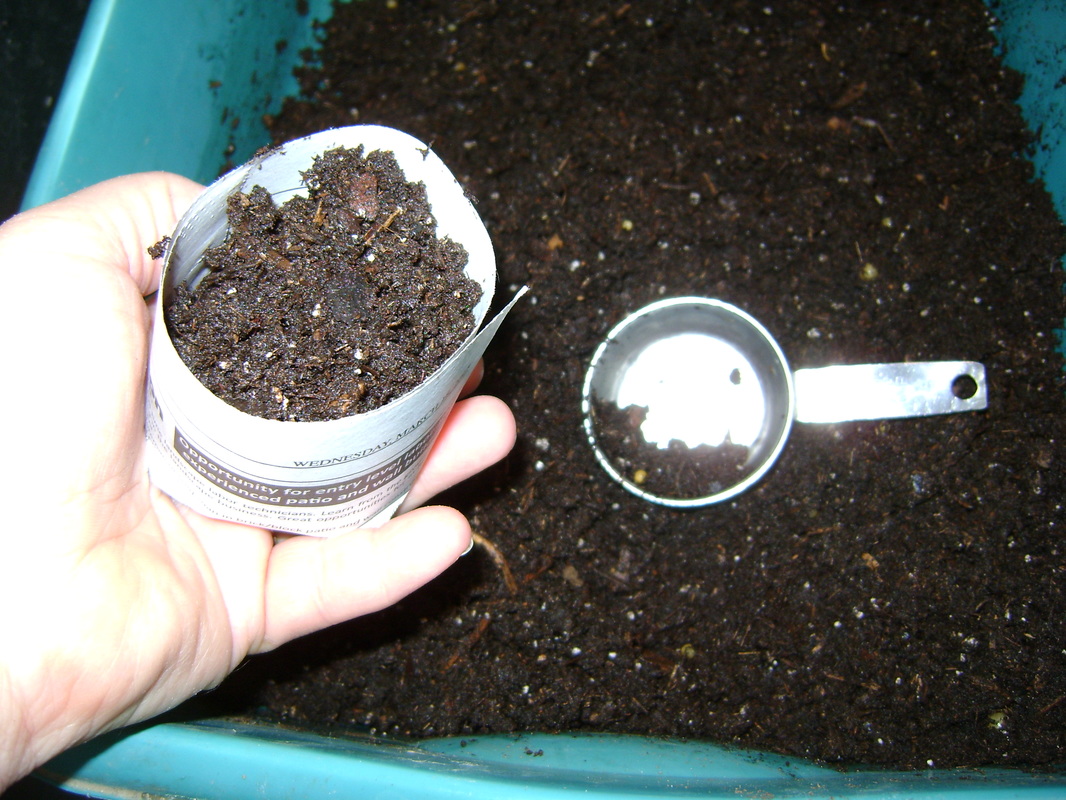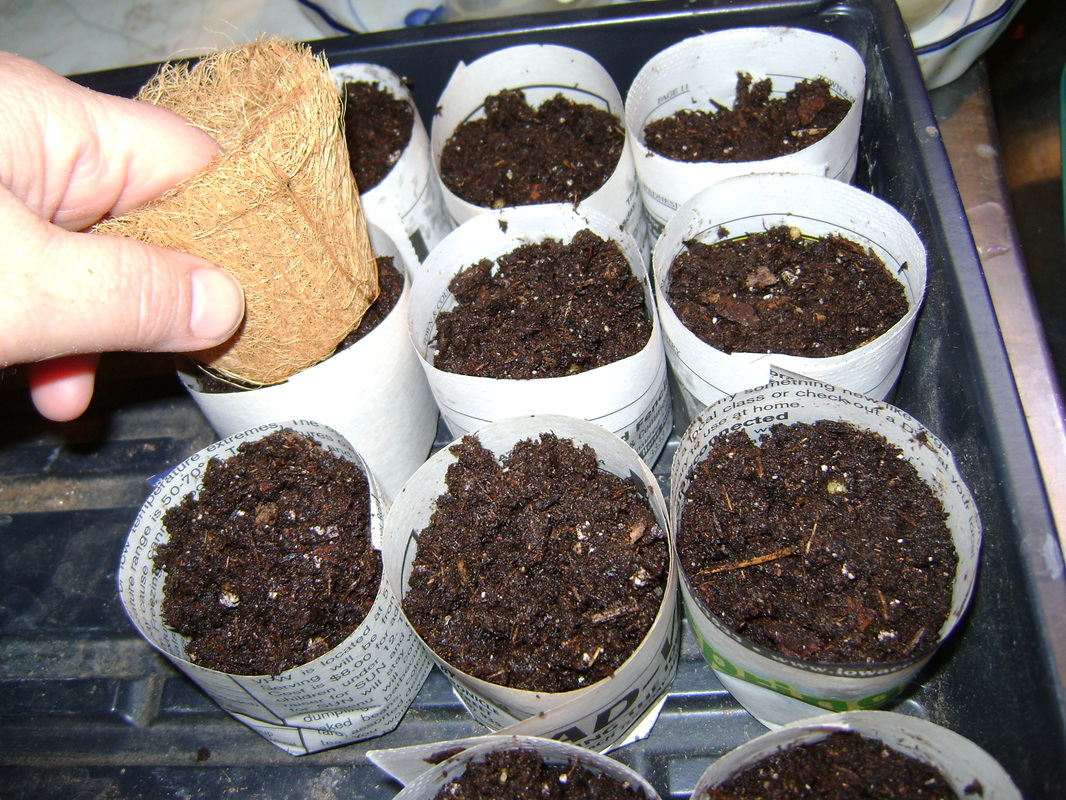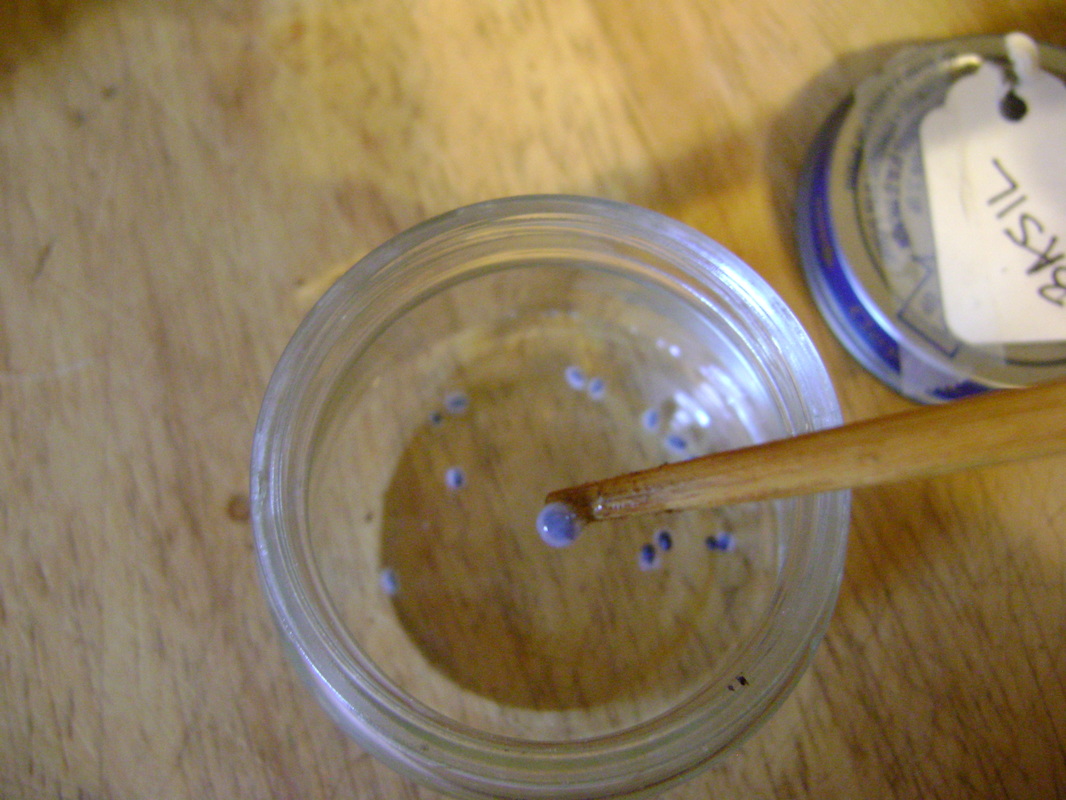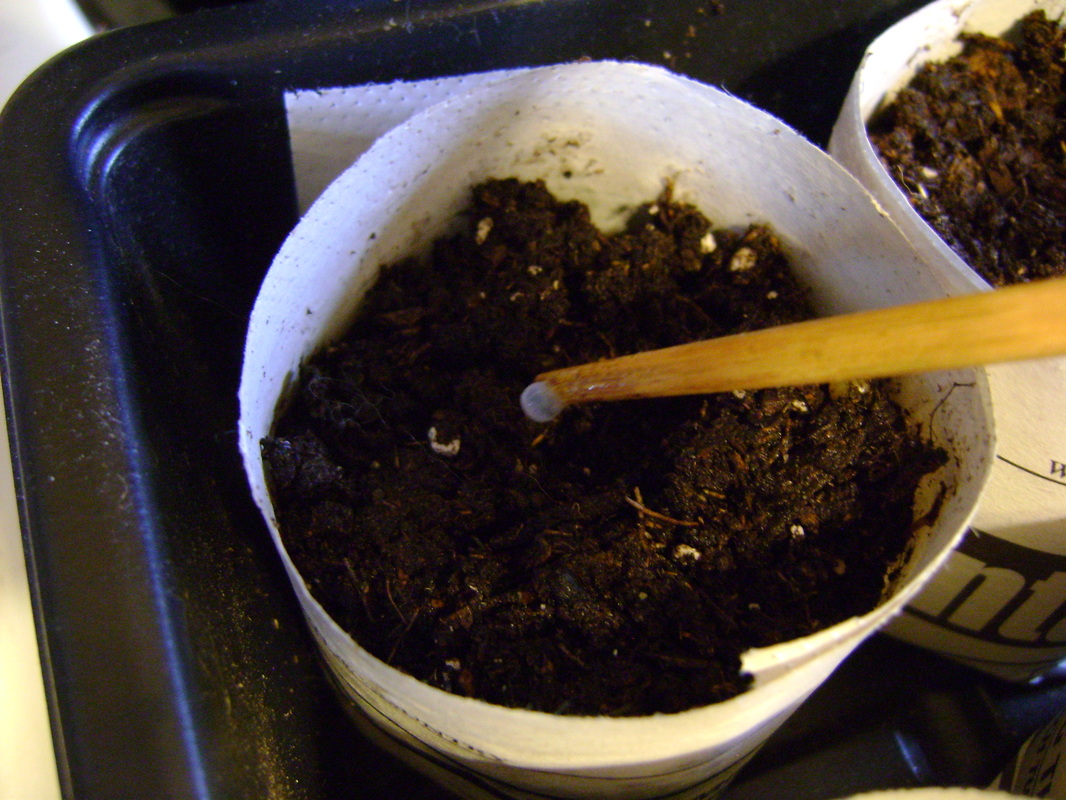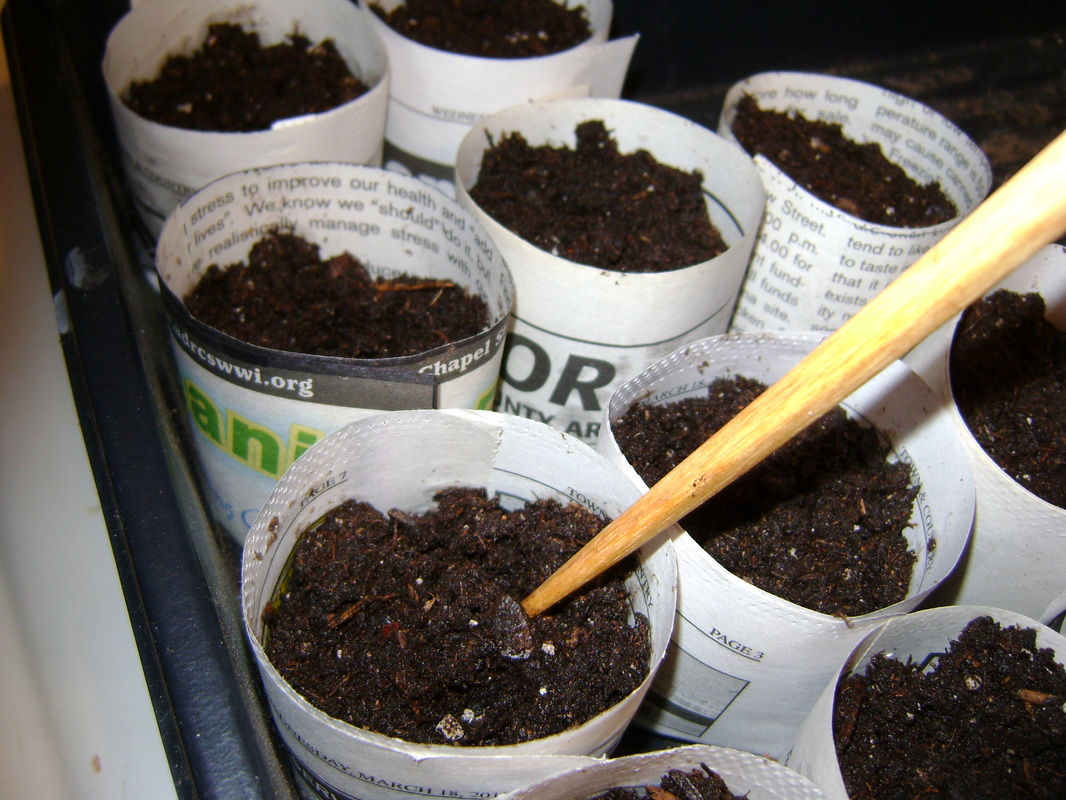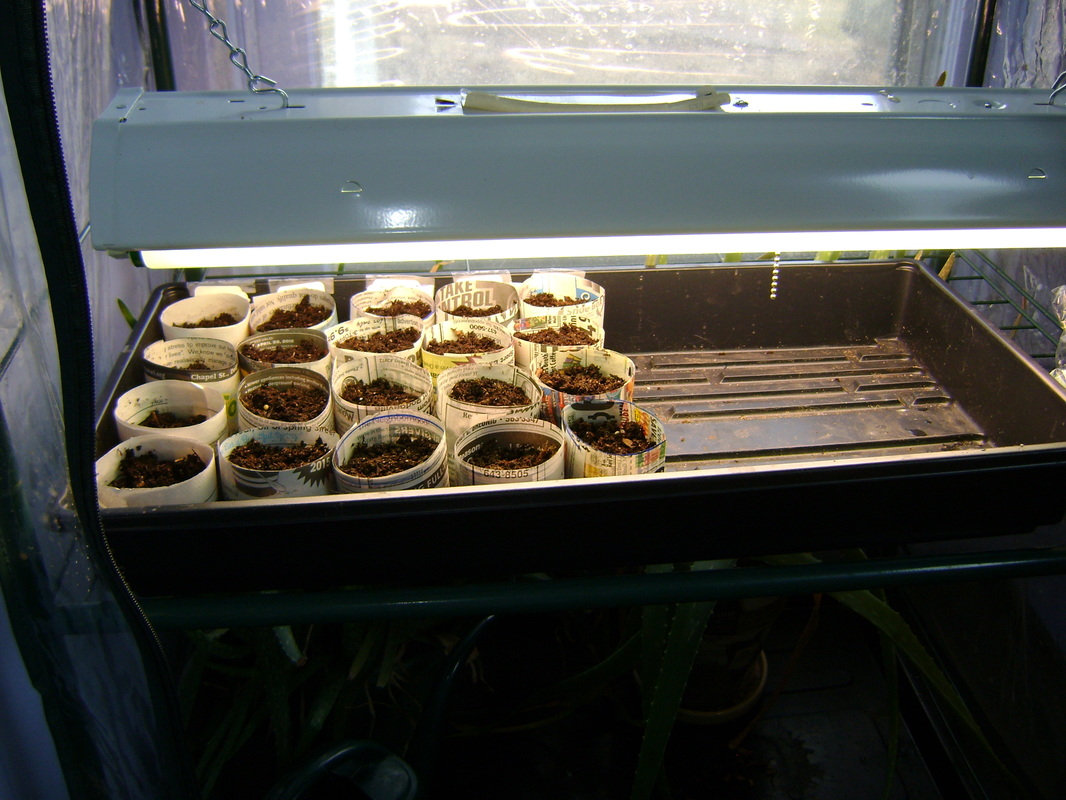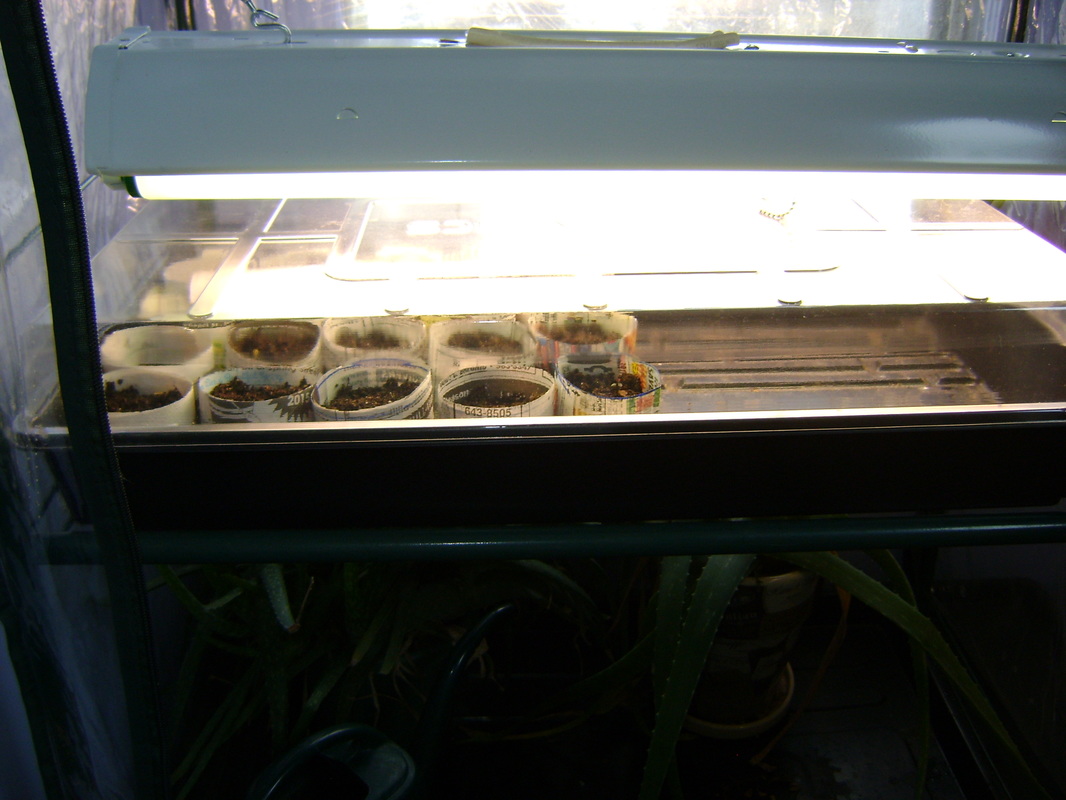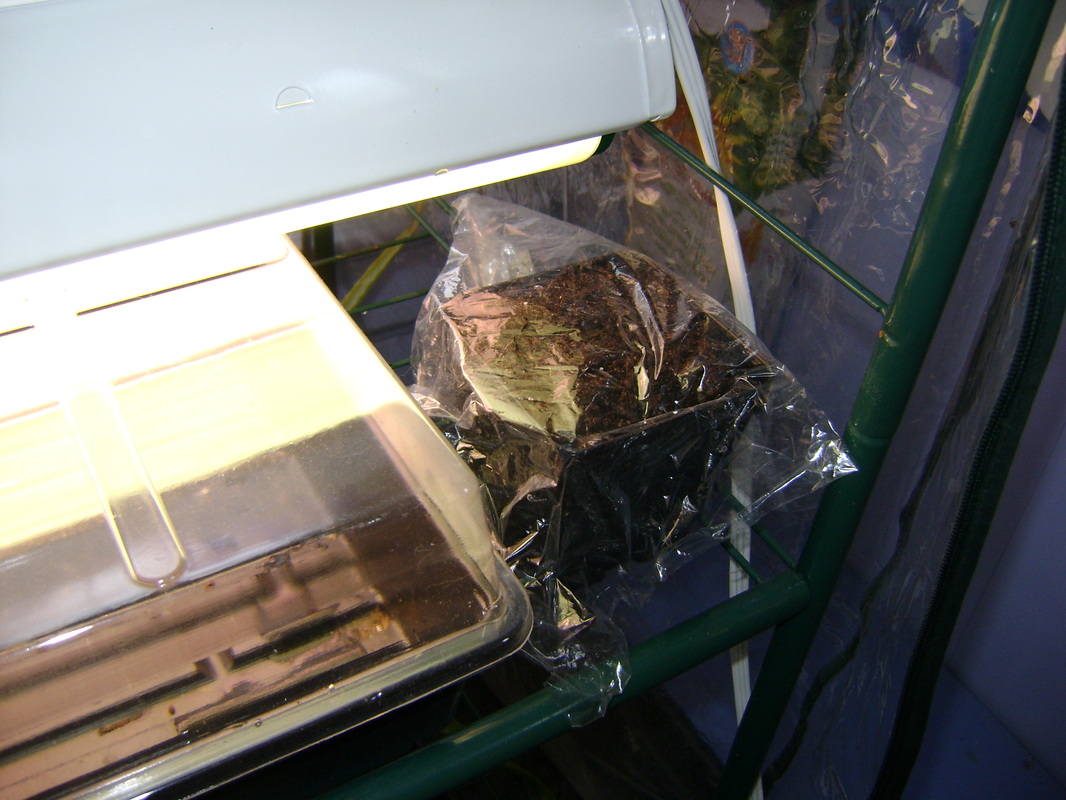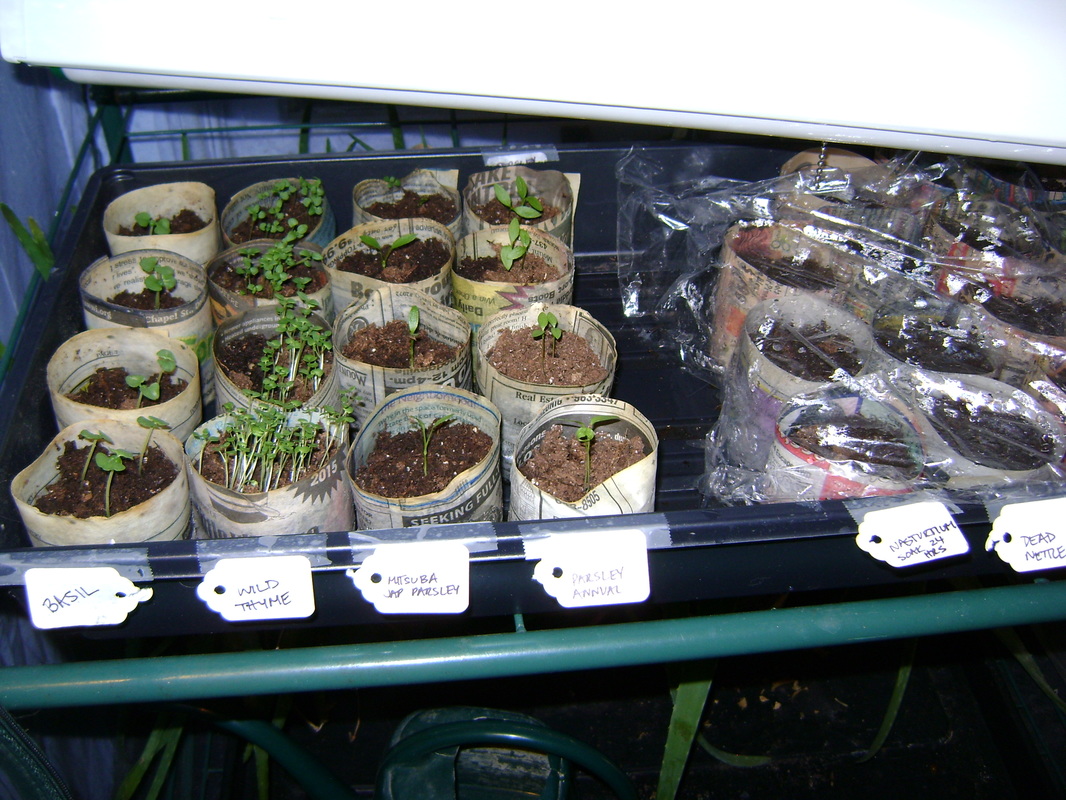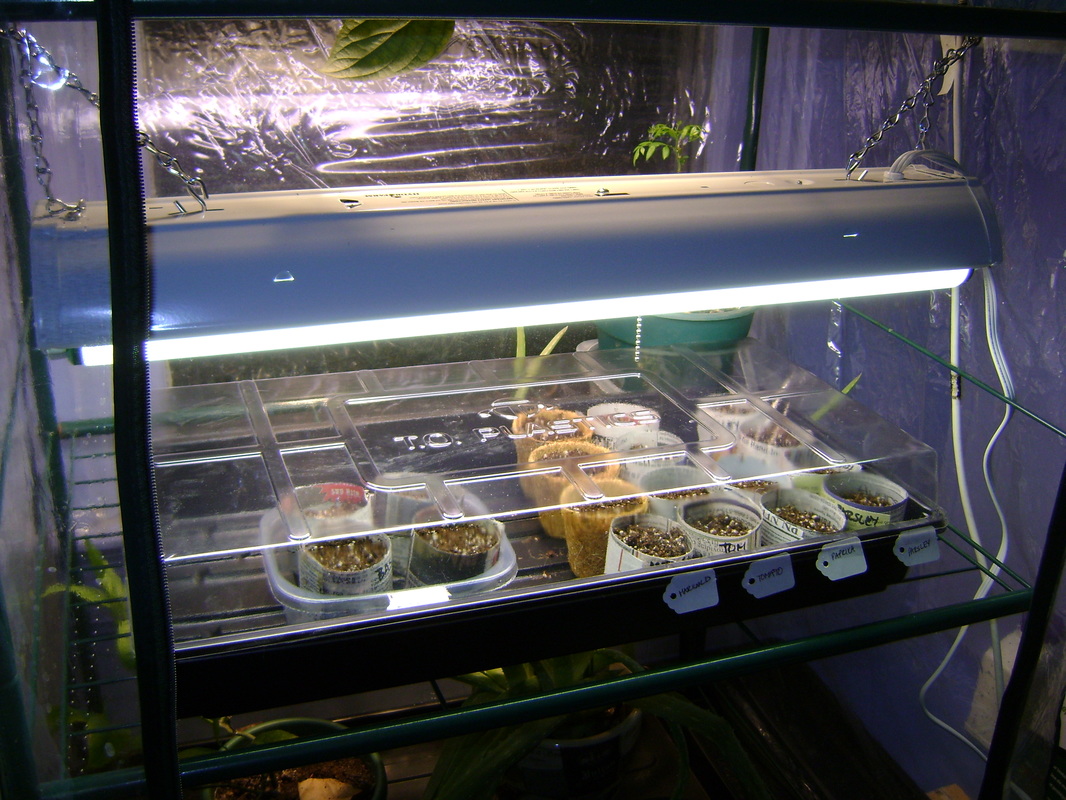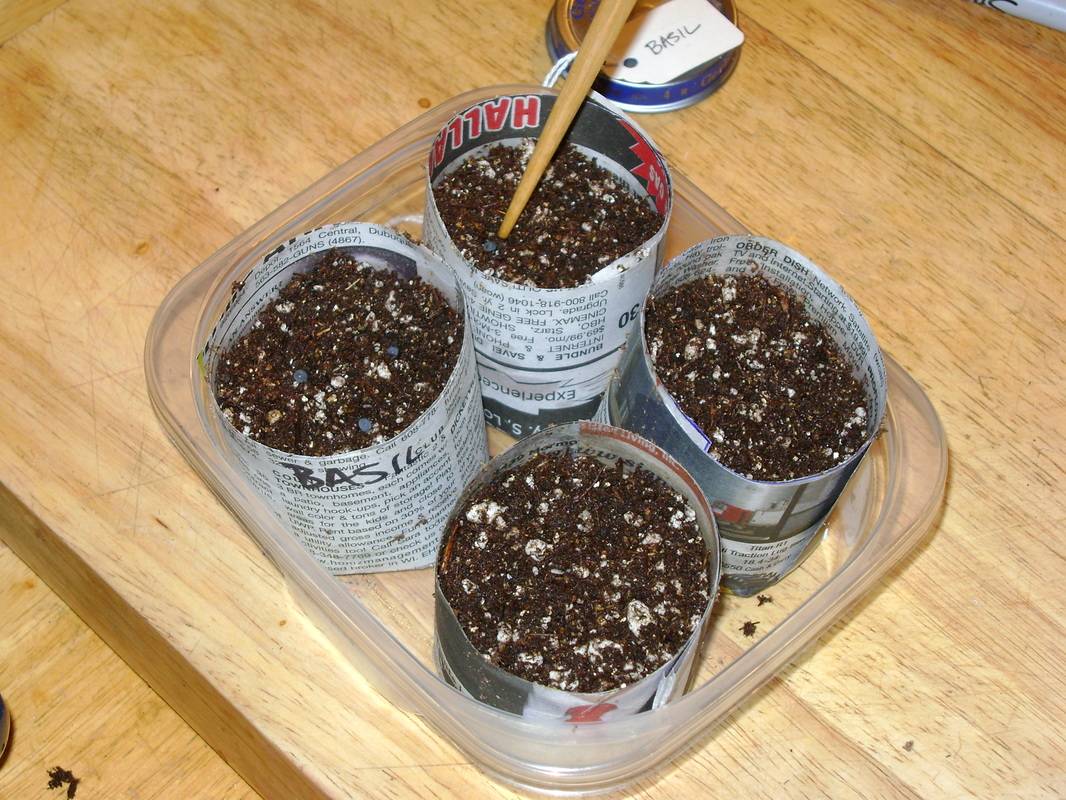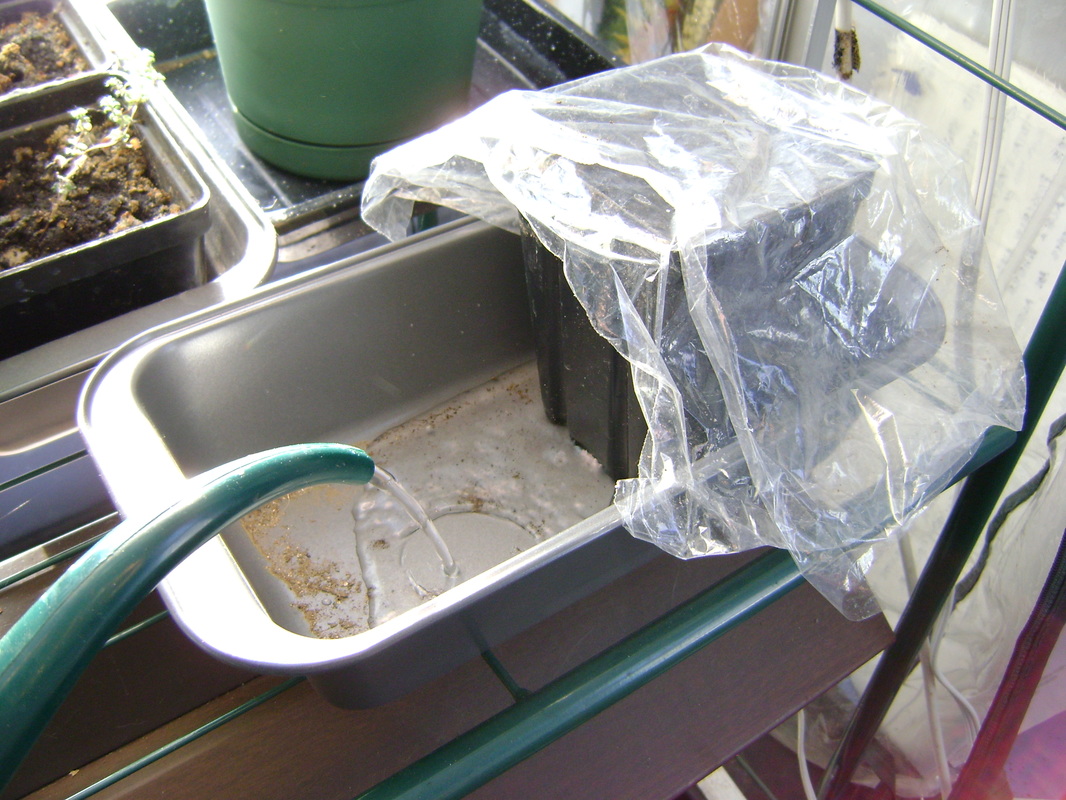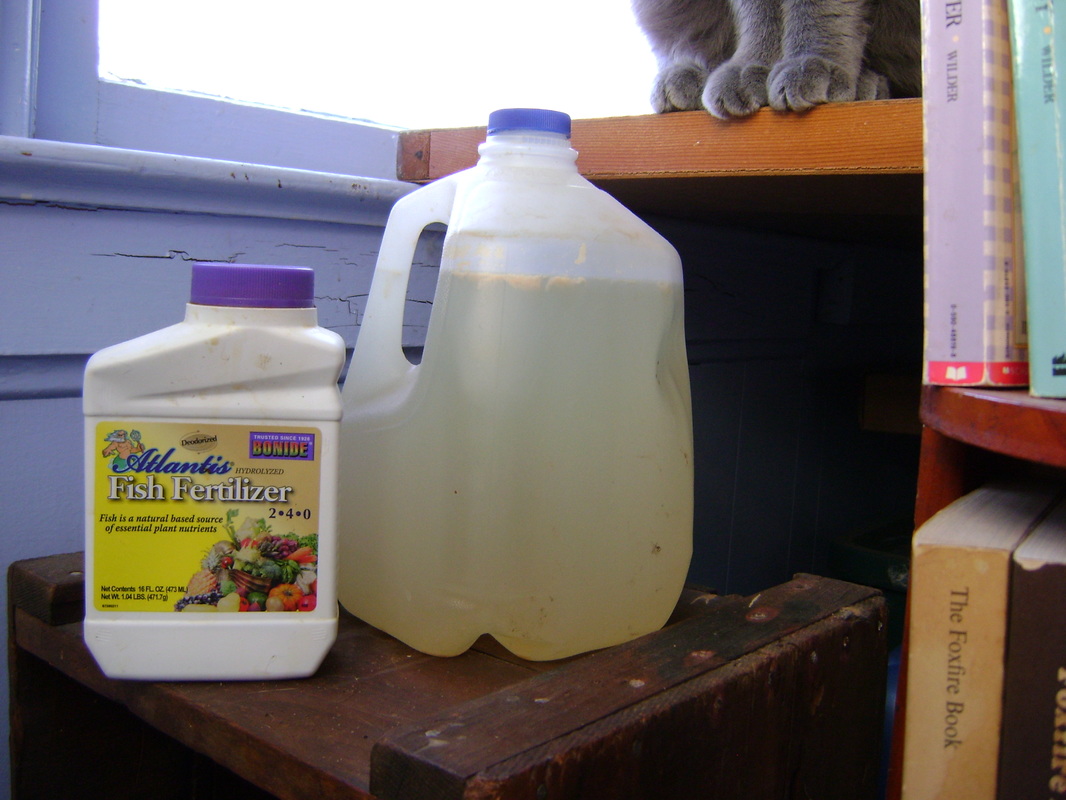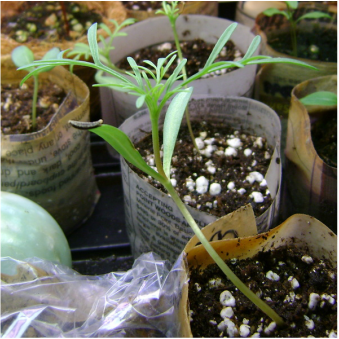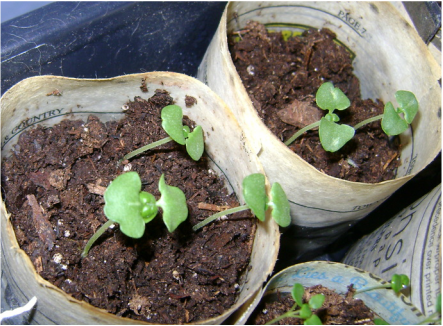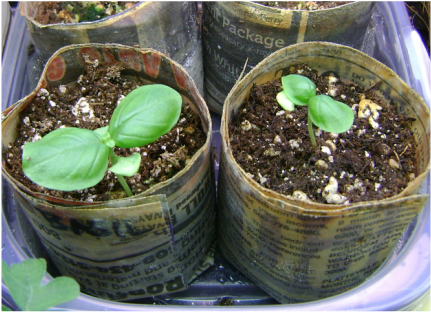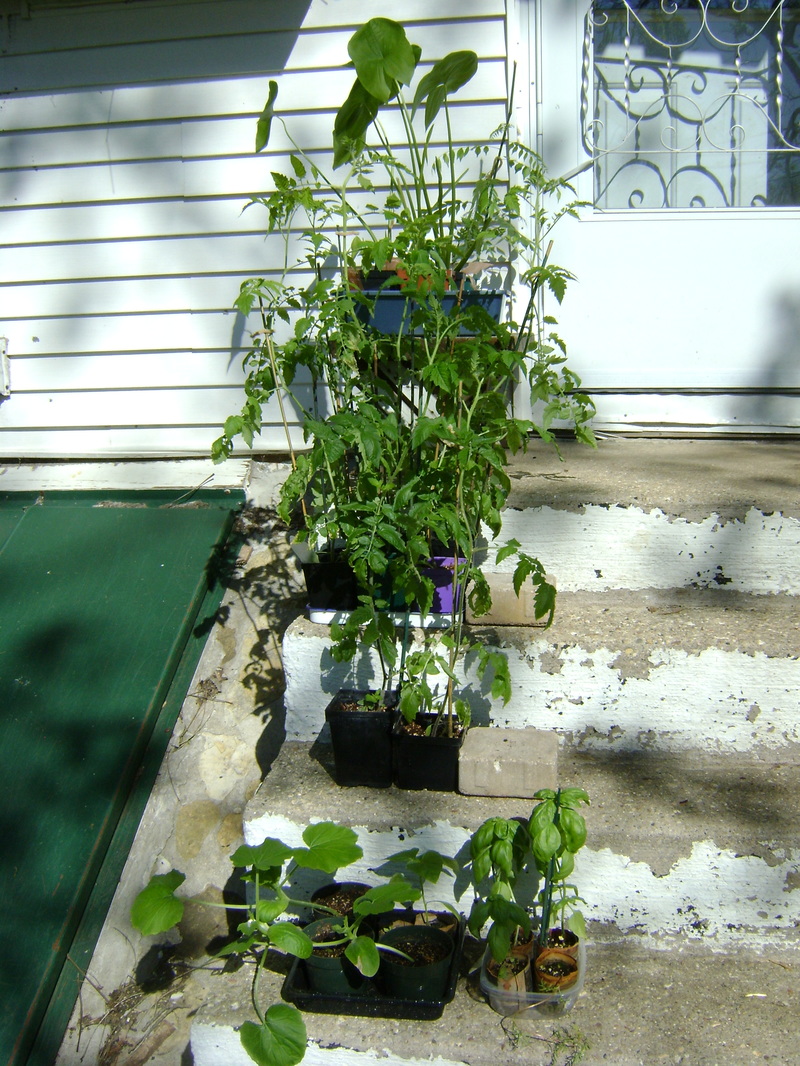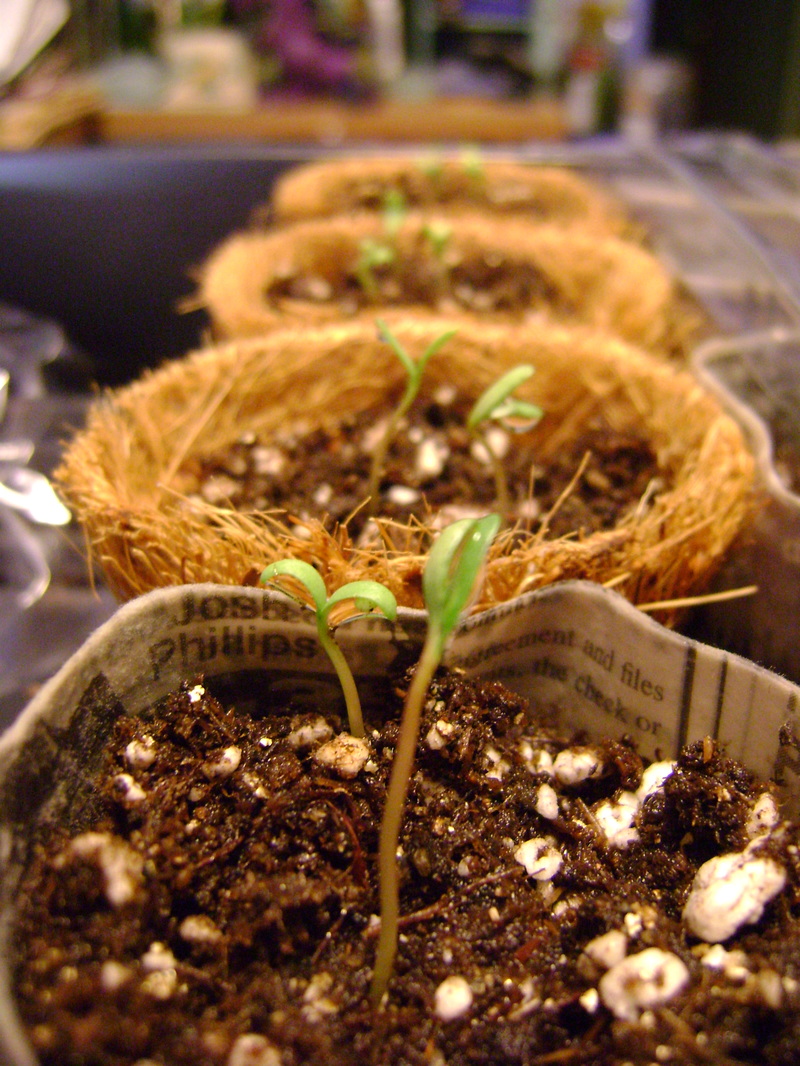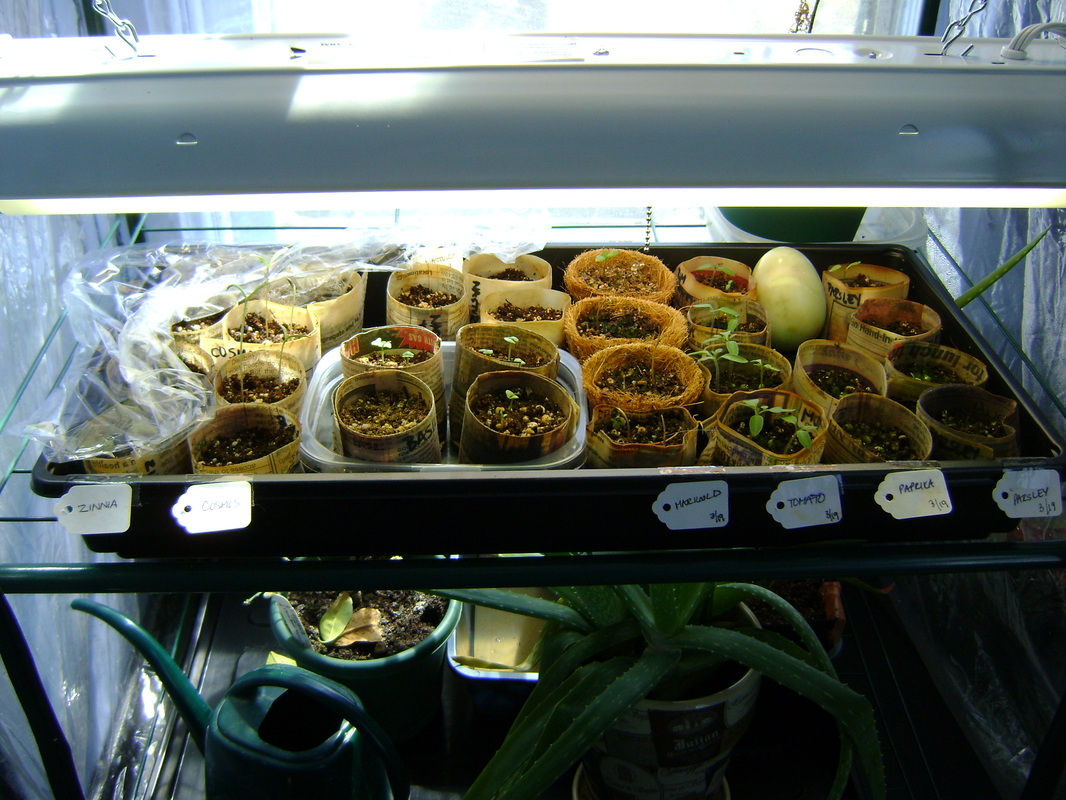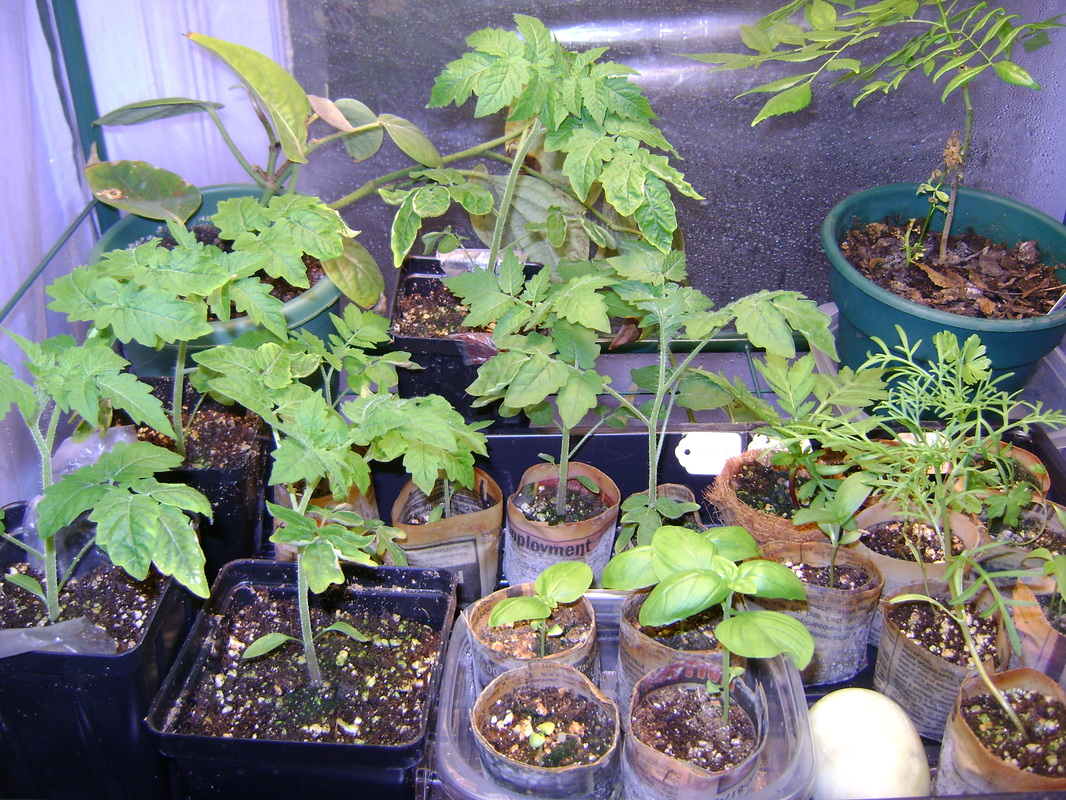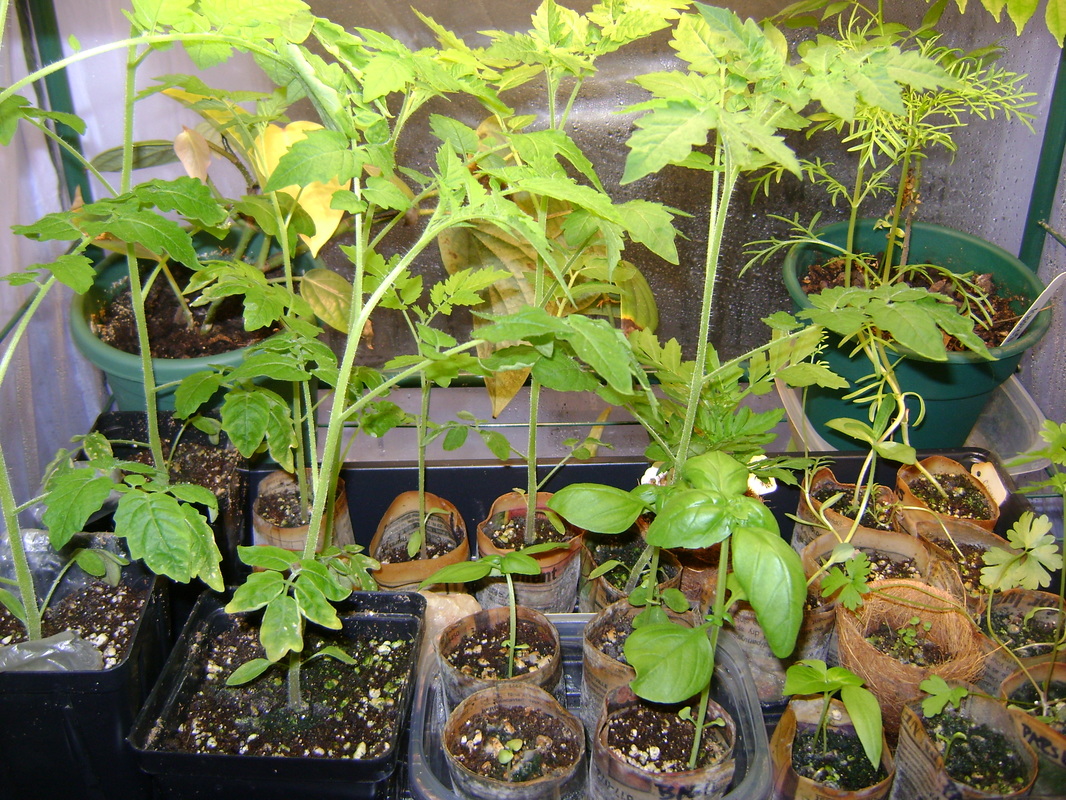|
Tomato Seedlings
|
STARTING PLANTS
|
My Seed Starting Greenhouse:To grow, seeds need adequate:
I use a small seed starting green house (left) to provide these necessities. It has several benefits:
Greenhouse Modifications:
|
|
NOTE: This type of greenhouse is not very strong.
The shelves are made of thin wire and cannot hold very much weight. It works fine for starting seeds, and can hold some small mature plants, but could not support large plants in heavy pots. Additionally, the shelves are relatively close together, so that tall plants do not have enough room to grow. But it will hold small cats! At our homestead, the greenhouse is a necessity because it keeps the cats away from the seedlings. Once I forgot to zip the door shut, though, and Ivy climbed inside (she politely wedged herself between the plants without hurting them). She is so skinny, she was seeking warmth too! |
Plant Lights - An Expensive Necessity:
For best results:
Lighting:
|
Make Your Own Pots:I've tried several types of pots for growing seedlings and have not liked most of them:
|
Newspaper pots have several advantages:
- Once you've bought the PotMaker (less than $15 new) you can make as many pots as you want for free with old newspapers.
- You can plant them directly in the ground or into bigger pots and they really will dissolve. It is also easy to peal parts of the pots away without hurting the plants right before you put them in the ground (assuming the newspaper is damp). This gives the roots plenty of room to grow right away.
- They can stand up to repeated watering. I worried that the pots would fall apart before I put the plants in the ground, since the newspaper should stay continually damp to keep the soil moist, but this has not been a problem. Initially, I doubled the newspaper, but found that this wasn't really necessary either. It is necessary to be careful when you move the pots. Lift them from the bottom so the newspaper doesn't tear.
PotMaker Instructions:
The PotMaker box has instructions on it, but they are brief. They could benefit from some more details and photos:
|
1. I created a template to help me cut the strips of newspaper to the right size. The box says the strips should be 3.5" by 10" (9 cm by 25 cm). I like to cut mine a bit taller, maybe 3.75". You can see where I've drawn the blue cutting lines on the newspaper below.
|
2. Grasp the larger, top part of the PotMaker by its round handle and wrap one strip of newspaper around the flat, bottom half of it. The newspaper will overlap itself and extend beyond the bottom of the PotMaker. Do not wrap it too tightly, or it will be hard to remove the finished pot later.
|
3. Turn the PotMaker upside down and fold the excess newspaper down toward the center.
This creates the bottom of the pot. Continue around until the entire bottom is folded in:
This creates the bottom of the pot. Continue around until the entire bottom is folded in:
|
4. Take the pot you've just created on the top part of the PotMaker and press it into the bottom, disc-shaped part. Press firmly and twist a bit. This is the step that holds everything together.
|
5. Remove the finished pot from the PotMaker. This part can be tricky and sometimes I tear them if they are too tight and have to start over. I gingerly grasp a tiny bit of the bottom and pull gently.
|
Pre-Soak Your Seeds Before Planting:
|
Other Seed Preparation Techniques:
Check the instructions on your seed packets. Some seeds require these advanced preparation techniques in order for them to sprout:
Check the instructions on your seed packets. Some seeds require these advanced preparation techniques in order for them to sprout:
- Seed Scarification: This means to nick the hard outer shell of the seed so moisture can get in. You can use sand paper, a file, or nail clippers. Scar the outer shell just enough so that you can see the inner layer, which is usually a lighter color.
- Seed Stratification: This means that seeds need to experience Winter before they will germinate. Check the package for further instructions. I usually put the seeds into some damp potting soil within a ziplock bag, then place the bag in the refrigerator. Periodically check to see that the soil is still damp. Seeds may need to be stratified for several months, so you'll need to plan ahead.
Planting Seeds:
|
1. Choose the "soil" you will be using to grow your seedlings. You can mix your own, but since I don't use much, I just buy a bag. Seed starting "soil" isn't really soil like what we see in the garden. It is lighter, so the seeds have an easier time pushing through it to grow. This bag of seed starting mix includes: sphagnum peat moss, vermiculite, and perlite.
|
2. Put the potting mix into a tub and add warm water a little at a time.
|
|
5. Tamp down the soil a bit to remove any air pockets. I use this fiber pot that is just the right size to fit within the newspaper pots. Then I use the tip of my finger or the wide end of a chopstick to make a depression in the center of each pot, in which I will plant the seeds.
|
6. I use a chopstick to transfer small seeds to the pots. Notice that the seeds have developed a whitish outer coating after soaking in water all night (see above). The seeds will cling easily to the small end of a chopstick.
|
Other Considerations:
- In most cases I only put one seed per pot. This goes against conventional wisdom that says that not all seeds will germinate, so you should plant multiple seeds in one pot and then kill all but one of them. I find myself generally bad at killing a plant after it has put so much effort into sprouting. In some instances, such as with basil, I can eat the extra seedlings (after cutting them at soil level with scissors so as not disturb the remaining sprout), since they are essentially microgreens. But in most cases I take my chances with one seed per pot, and on the whole, they have mostly sprouted.
- For larger plants, I put the seeds directly into big plastic pots. If I have room, I do this with any plants that I expect to outgrow the newspaper pots before I can plant them outside, such as tomato seedlings.
Put the Seeds in the Greenhouse:
|
1. Transfer your newly planted seeds into your greenhouse. The plant lights should be on 24 hours a day until the seeds sprout (see above).
|
2. I put all the pots onto trays to make moving them around and watering them easier. These seedling trays are sold with other seed starting supplies. They come with a plastic lid that helps hold in heat and humidity to encourage growth. It's good to keep the lids on until the seedlings get too tall.
|
|
3. If you're using larger pots, you can cover them with plastic wrap to create the same effect. I just lay it over the top of the pot. Note that if you're careful, you can reuse the plastic wrap year after year.
|
4. You can also use plastic wrap to cover part of a tray of seedlings, since if you're only planting a few of each type like I do, they often need to be planted at different times.
|
|
5. To identify seedlings, I transfer the price tags that I taped to the top of the seed soaking jars to the outside of the tray where they'll stay drier. I find that if I write on these tags with permanent marker, I can reuse them for several years too.
|
6. It's also possible to use a thick permanent marker to write the plant name on the outside of the pots (see the "BASIL" on the left pot below). It does not smear when the pot gets wet.
|
Watering the Seedlings:
|
1. The soil should remain continually moist. You can see in the photo below that the soil in the pots on the right and nearer the front is a lighter brown than the others. I have let them dry out too much. If you're using newspaper pots, you know you should water whenever the paper has dried out, which generally happens before the soil becomes dry.
|
2. The best way to water is from the bottom. This is one of the problems I had when I first tried to grow plants from seed. When I poured water into the top of pots, it would swamp the fragile seedlings and sometimes knock them over. I tried spraying the seedlings instead, but it was very hard to spray them enough to keep the soil damp. Instead, I now pour water into the trays, and the pots soak up the water from the bottom without injuring the plants. Be careful not to over water with this method. If the soil and pots are both damp and there is still standing water, you've added too much.
|
Fertilize Seedlings
|
Examples of "True Leaves:"
|
Hardening Off:
|
This is the hardest part of the process for me. In theory, it's supposed to work this way:
|
Another suggestion: To simulate wind, you can put a small fan in the greenhouse. I have a battery operated, handheld fan that I turn on for a few hours periodically, once the plants have grown to a reasonable size. It helps their stems stems grow stronger.
When Do You Start Your Seeds?Click to download my Seed Starting Date List, which can be modified for your area and the plants you want to grow.
|
PHOTO INSPIRATION
If you give seeds the right conditions, they will grow!

